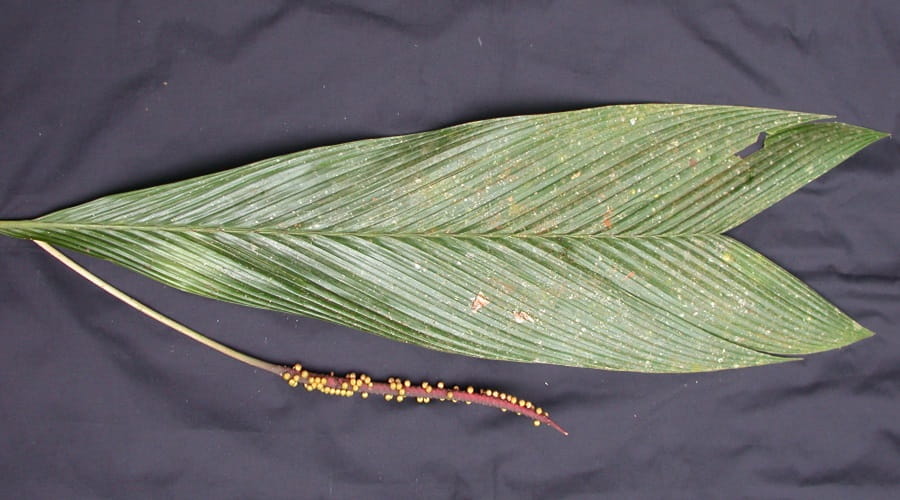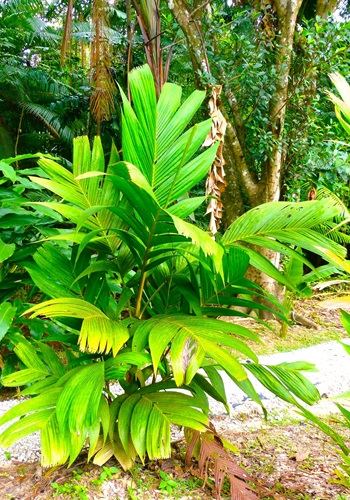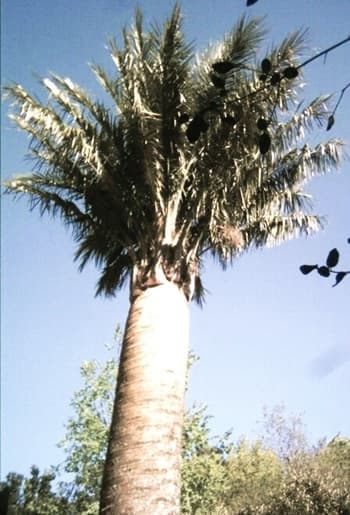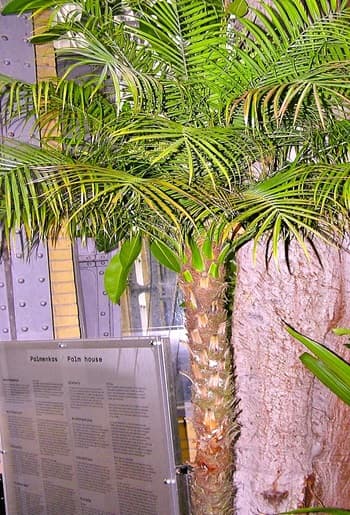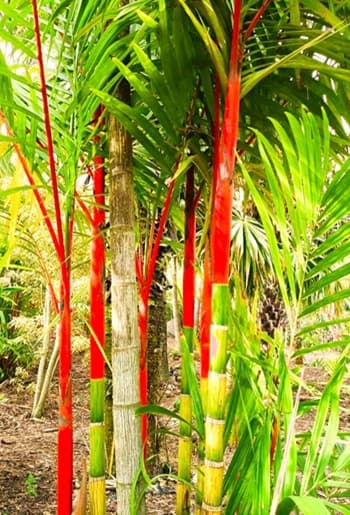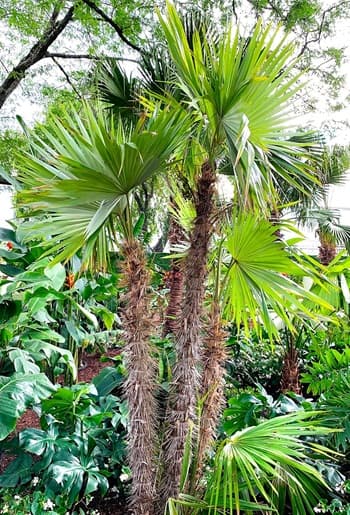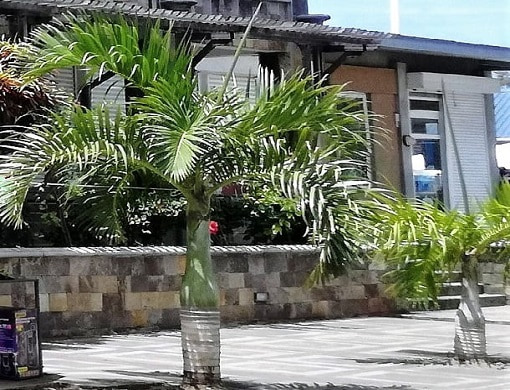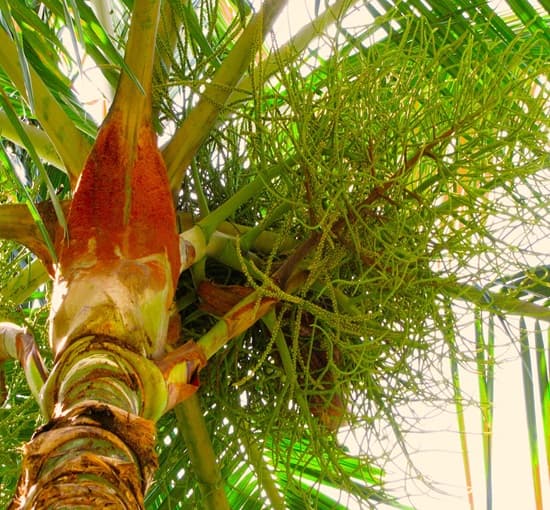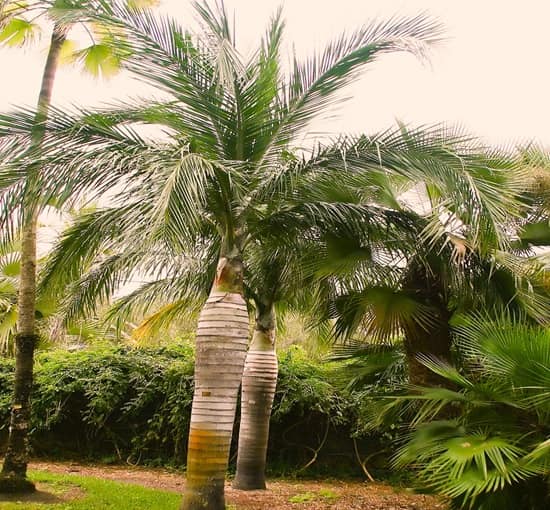- Home
- All Kinds of Palms
- Identifying Palms
How to Identify Palm Trees
How to identify palm trees - that's your question! You've noticed all the different types of palm tree species aren't alike. Their leaves can be way different from each other. Then there's flowers, trunks & more. All used for palm species classification & identification.
When wondering how to Identify Palms, consider that there are over 2700 different types of palm trees to go through! So many different species!
Species identification isn't an easy task, but you can get started on it. Let's begin learning how to identify palm trees.
Some have fan-shaped leaves, others have feather-shaped fronds. What Does That Mean?
Other ways they can be sorted.
- For instance, the way Trunks of Palms Grow.
- Or do they have edible fruit? Are they a slow-growing tree?
- If they can Survive Cold Winters.
But we'll concentrate on the essentials to get you going.
Once you decide on the palm tree's genus, identification becomes a little easier. Beginning with some Basic Steps. The Palm Parts that help are Their Leaves, and The Trunks. Plus looking at how to identify palm trees by the Way They Grow. Finally, take a look at the Flower Stem.
Here we'll help guide you in figuring out which palm tree you're viewing.
At Mission: Palm Trees
Palm lovers can soothe their palm-related searches and concerns. Our articles are intended to inform, while having fun, easily Finding What You Want or Need. Without unneeded shoptalk & tiring endless research. We Research For You!
Sorting Out Different Palm Tree Types

Let's decipher this, so you'll to learn how to identify palm trees.
Basic Steps for Learning How to do
Palm Tree Identification
Going through these steps, will help to begin narrowing down the main differences of palms. You'll be on your way to figuring out how to identify palm trees!
1) Look at the Palm Plant's Green Leaves. What's their overall formation?
2) Look at the palm's trunk. The Many Trunk Differences help you gather info for what it can be. How they look & how they grow.
2a) Does the trunk Have A Crownshaft?
3) Look for the Palm's Flower Stalk - the inflorescence.
Take it all step by step. Most of the time you'll figure out the genus first.
Then Palm Tree Guide Books can guide you more directly to the right palm.
How Palm Tree Fronds Can Help With Identification
When you're trying to identify a palm tree, about the first thing to do is look at palm leaves. The fronds. Palm fronds give you initial basics for sorting out different types of palm plants.
 Palm Plant Identification Techniques - Oh You Really Don't Need a Magnifying Glass! 😉
Palm Plant Identification Techniques - Oh You Really Don't Need a Magnifying Glass! 😉First Start Figuring out Fronds for Palm Tree Identification
Ask yourself these questions about the palm's leaves.
First, look at the leaf as it grows from the trunk. Decide what type of frond it is:
- Do leaflets spread out from one center point?
- Then they're Palmate: Typically nicknamed fan palms. As they resemble a circular fan.
- But think of the term palmate. The fronds may also resemble a hand. Having the palm, with fingers coming out.
- Are the leaflets placed lining up along one center stem, on both sides of the stem?
- Then they're Pinnate: Think of a feather-like frond, like a bird. Or a ferny look. The small leaflets are arranged along the stem (rachis), having a feathery appearance.

- Does the leaf structure look different from either of those? Very helpful discovering another type yet!
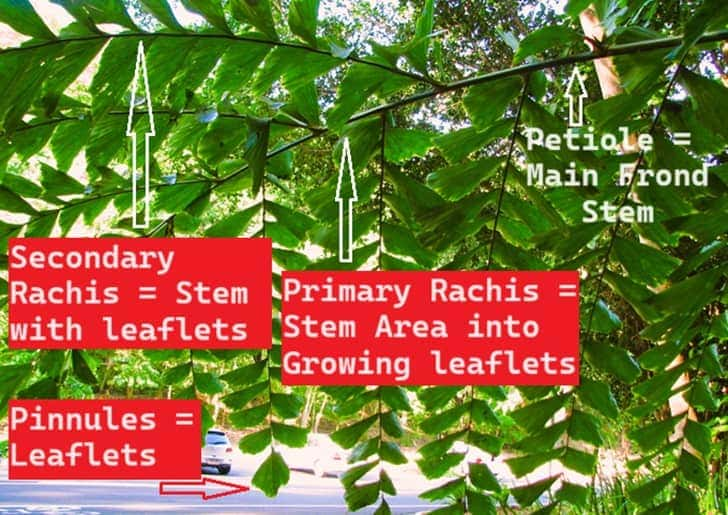 These are the Bipinnate fronds. The entire branching is the leaf.
These are the Bipinnate fronds. The entire branching is the leaf.The only Bipinnate leafed palms are in the Caryoteae palm tribe.
Those are the Arenga, Caryota & Wallichia genera. Each leaf shape has a stem (petiole becoming the rachis) with sub-stems arranged in a row along the main stem. Then each of the sub-stems contain leaflets.
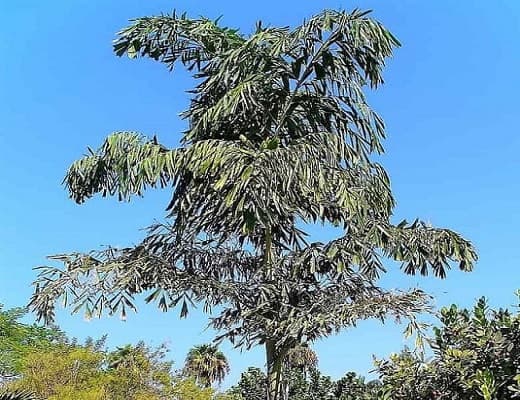 Bipinnate Caryota maxima - Native to Southeast Asia.
Bipinnate Caryota maxima - Native to Southeast Asia.Photo: H Zell - CC BY-SA 4.0
- Is the palmate leaf instead truly a costapalmate frond? They're not that common. But one of them is the Vanuatu Fan Palm.
- They're palmate looking leaves, but the petiole enters into the palm's blade, the green mass of the leaf.
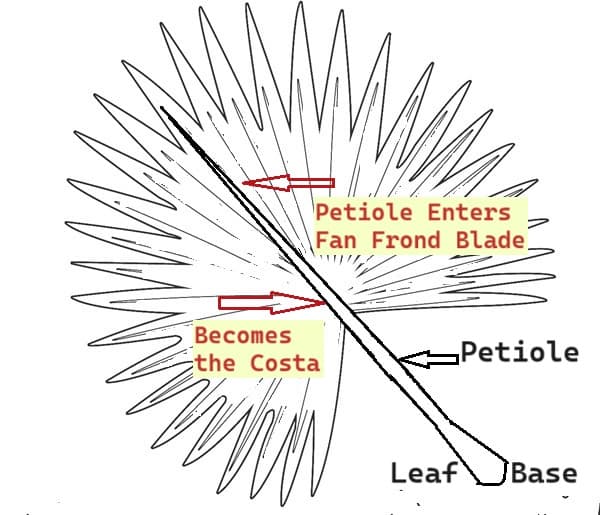 A Costapalmate Design for Palm Fronds
A Costapalmate Design for Palm Fronds- Is the palm leaf fully whole, without segments or leaflets?
- They're called Entire Leafed Palms.
- Yet, some have notches going from the outer point of the frond. Notches can be very short, or go deeply half-way into the frond blade.
Examples are:
- Other facts when viewing some entire-leaf palms.
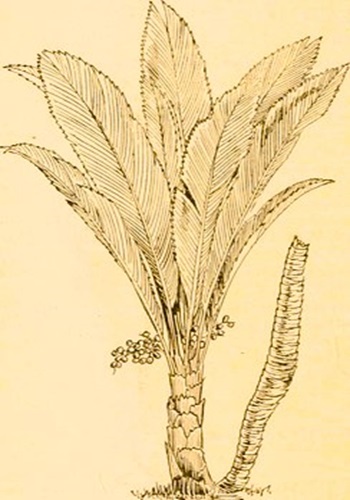 Vintage drawing of the Manicaria saccifera.
Vintage drawing of the Manicaria saccifera.Showing this Entire-Leafed Palm in its Whole Form.
Once the frond style is figured out, you could even go deeper, ruling out one genus or another. By asking...
- Does the rachis and/or petiole have thorns?
- Several Braheas have petioles with thorns. Take a walk around a Brahea Garden...
- On fan palms, how deep are the separations between the segments of the fan-shaped fronds?
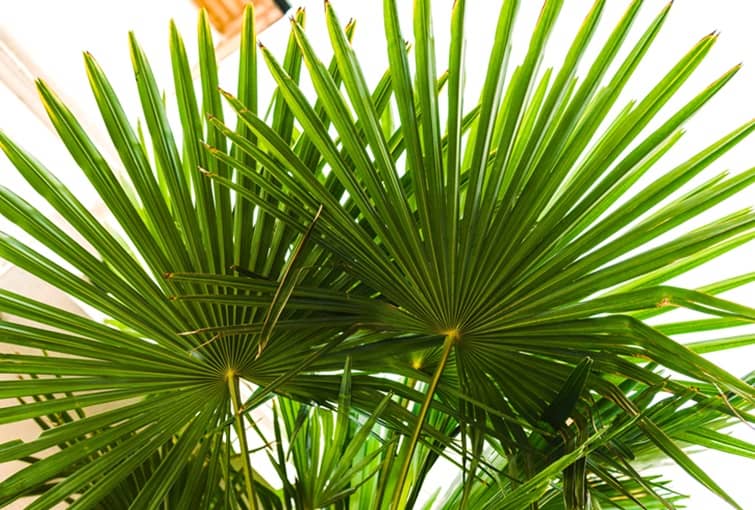 Segments Have Deep Separations
Segments Have Deep Separations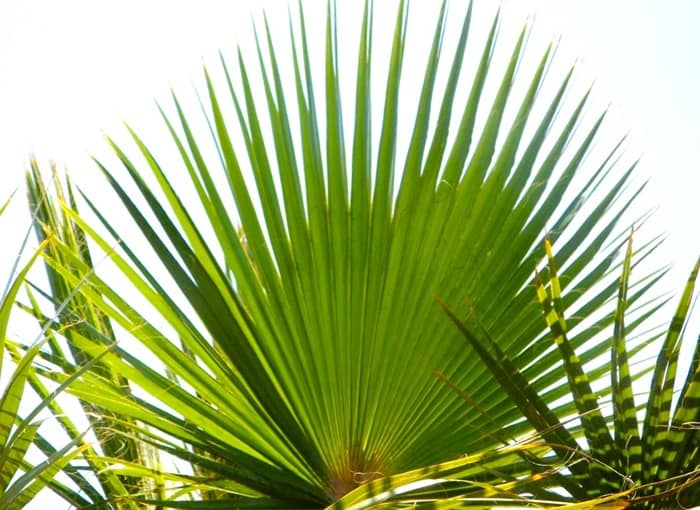 Segment Separations About 1/2 Way
Segment Separations About 1/2 Way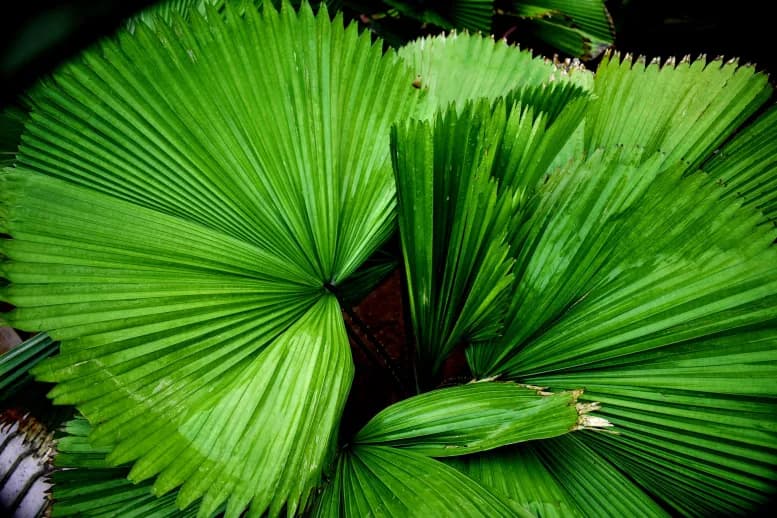 Minimal Separations Between Segments
Minimal Separations Between Segments- On feather palms, how are the leaflets arranged? Evenly or unevenly on either side?
- Do the leaflets droop downward, or grow upward.
- Do tips of leaflets become a spike?
- Most species leaflets go downward from the center, into an upside down V-shape. Although some fold upward, into a V shape.
Sort Palm Trees by Their Trunk for Identification
Palm trunks come in a many forms. With different colors, a slender trunk or thick trunk, varied smoothness & shapes, and how they grow from the ground.
Their overall appearance may be...
- Smooth with a mostly even color all the way up to the leaves.
- Showing leaf bases along the trunk. They're leftover hunks from old fronds.
- Have types of rings all up the trunk. They could be smooth or bulging. They may be colorful. Some even imitate bamboo!
- Very spiny - dangerous looking!
Or they may have...
- Some Roots Exposed Above the Ground.
- A unique look, shaped quite differently.
- Grown with a crownshaft at the top.
Guide to Identifying Palm Trees Using A Crownshaft Trunk
A great identification sorter is knowing the Palm Has a Crownshaft. Having unique characteristics.
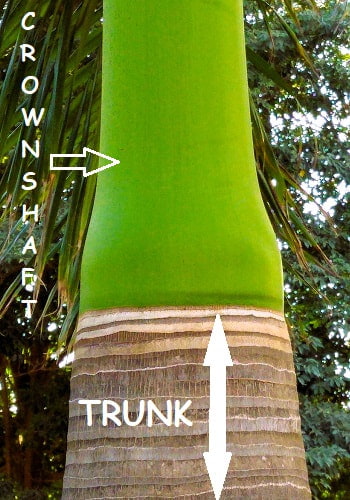
Some palms have this feature. Located at the top area of the trunk. It's a glossy sort of area, often green. But they can have vibrant colors. See if you agree with us, that they only add to the palm's beauty.
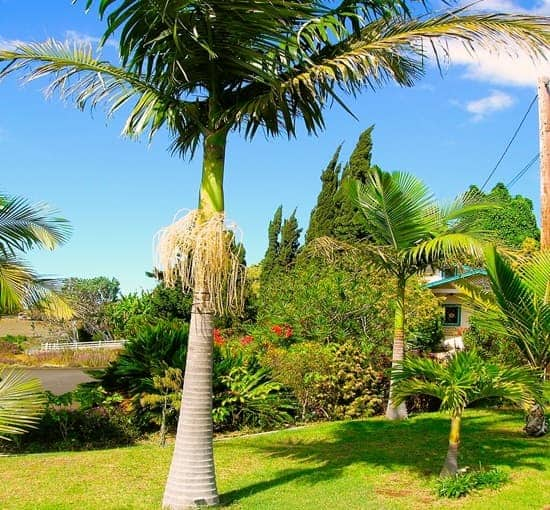 Archontophoenix alexandrae With Flower Stalk
Archontophoenix alexandrae With Flower StalkPhoto: Forest & Kim Starr - CC BY 4.0
 Rhopalostylis baueri
Rhopalostylis baueriNorfolk Island, South Pacific Delight
How Identification of Palm Trees by the Way They Grow Helps
When deciphering how to identify palm trees, growth habits are very important. What ways can they rise from the dirt? Growing into a small tree or tall palm trees.
Identifying Types Of Palms That Are Tree Like
Most people think of this type of palm, when hearing "Palm Trees." But they're definitely not an actual tree.
Tree-like means they have a single trunk, a solitary tall trunk. They can be small palm trees, too. These palm tree trunks come in all heights.
And they almost never have branches growing out from the trunk. Instead, individual leaf stems (petioles) grow out near the top. Forming the palm's crown.
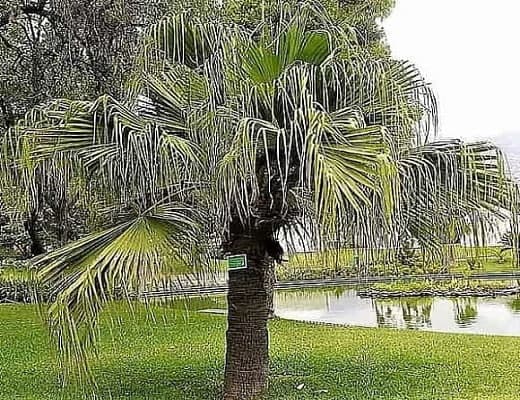 The Chinese Fan Palm Can Survive Cold Temperatures.
The Chinese Fan Palm Can Survive Cold Temperatures.A Slow-Growing Solitary Fan Palm
When Fully Grown the Livistona chinensis Can Reach 40' Tall.
Identification Guide for Shrubby, Clustering Palms
Some palms appears bushy. Like a typical shrub. The shrubby appearance is from spreading out via suckers. Suckers grow off the main stem. Making them a multi-trunked palm. Some grow as wide as 10 feet.
They're often short. Therefore, many are used as Indoor Palm Tree Choices.
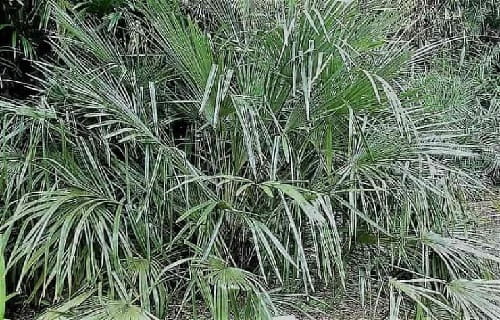 Rhapidophyllum hystrix - Native to the Southeastern US.
Rhapidophyllum hystrix - Native to the Southeastern US.Nursery Sales Popularity has led to Rare Status.
Photo David J Stang - CC BY-SA 4.0
Needle Palm, AKA Creeping Palmetto, Blue Palmetto, Dwarf Saw Palmetto, Spine Palm, Hedgehog Palm & Vegetable Porcupine!
Identification Guide for Viny Climbing Palms
A large group of climbing palms are called rattans.
They grow in tropical climates, in rain forests. They don't want full sun! Clinging to any nearby tropical plant, to grow high up into canopies.
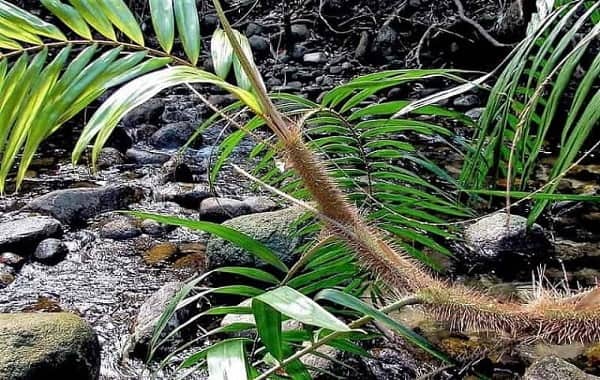 Australian Rainforest Climbing Rattan Palm About to Grab Hold & Go Up! Photo: Tatters @flickr - CC BY 2.0
Australian Rainforest Climbing Rattan Palm About to Grab Hold & Go Up! Photo: Tatters @flickr - CC BY 2.0Two climbing vine palm categories aren't rattans. One subfamily is Ceroxyloxideae in the Chamaedorea genus.
Others are in the genus Desmoncus. Six of their seven species are climbers.
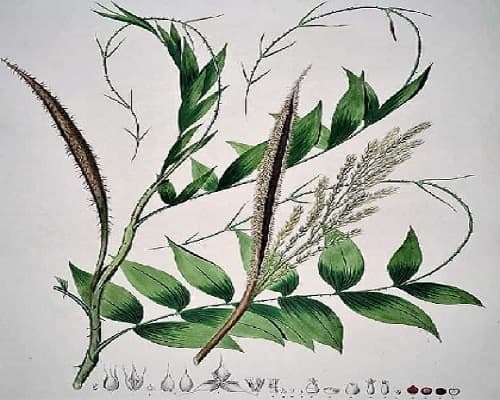 Artist's Depiction of a Climber, Desmoncus polyacanthos
Artist's Depiction of a Climber, Desmoncus polyacanthosIts Scientific name is Greek for Many Banded Hooked Spines
See Its Grabbers for Climbing?
How to Figure Out & Identify Trunkless Palms
Called acaulescent palms.
The botany term for having no stem, or seeming to have no stem.
Even though called trunkless - really, it's just that the trunk is hidden. Growing below the ground, with a subterranean trunk. The Dwarf Palmetto (Sabal minor) is a prime example.
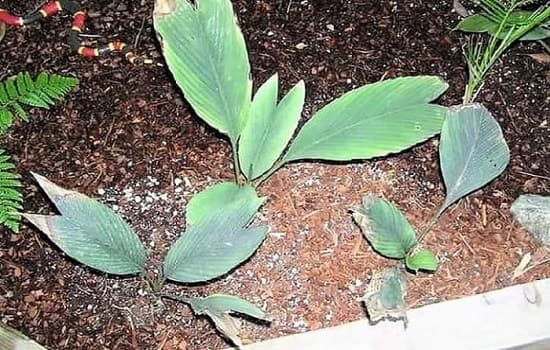 Can You Find the Trunk or Stem? No! It's Beneath the Soil
Can You Find the Trunk or Stem? No! It's Beneath the SoilThe Sullivan Palm (Chamaedorea sullivaniorum) is rare, Native to Panama. Now What Else Do You Note, for Identification?
Other times, trunk stems creep along the ground.
Making it seem like there is no trunk. But it's being a trickster!! This Brahea decumbens palm does that!
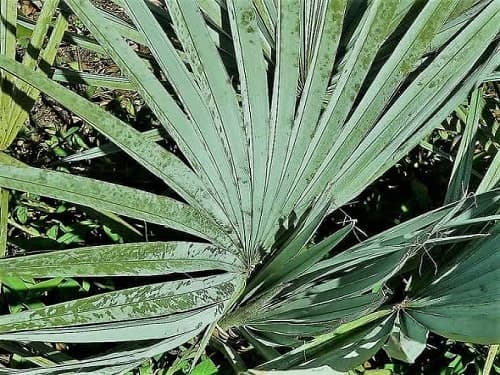 Usually Grows in Clusters - Making a Dense Clump.
Usually Grows in Clusters - Making a Dense Clump.They Sprawl Along the Ground!
Sometimes Used as a Palmy Type of Ground Cover.
Photo: Stan Shebs - CC BY-SA 4.0
Check the Palm Tree Flower Stalk - for Identification
Mature palms always produce flowers, around springtime.
Usually growing anywhere from one to five branching stalks. Most flowers are tiny, growing from the stem, called the inflorescence.
They're not often very showy. The flowers themselves don't help much when looking for how to identify palm trees.
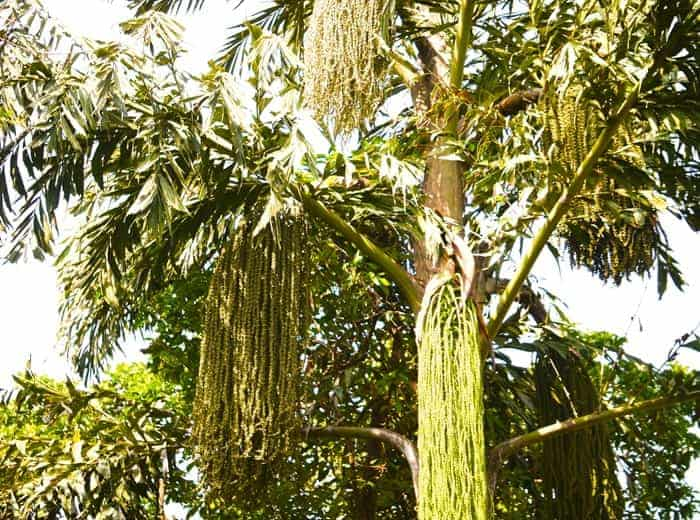 The Toddy Palm's Flowers Hang Downward 10ft/3m, helping for your palm identification.
The Toddy Palm's Flowers Hang Downward 10ft/3m, helping for your palm identification.Photo: Dinesh Valke - CC BY-SA 4.0
What does help narrow down Genera, is where exactly does the inflorescence grow out from the trunk. Several possibilities:
- With crownshaft palms, inflorescences grow immediately above or immediately below the crownshaft.
- Rarely they grow at the trunk bottom, or even from underground.
- Often they grow from amidst the leaf crown, called axillary inflorescences. Some go upwards, for a stunning look.
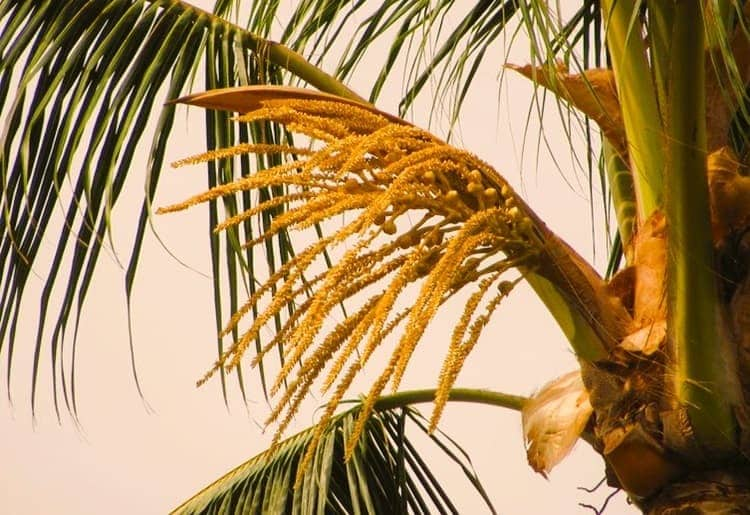 Coconut Palms Regularly Grow Short Inflorescences. Fruiting will be Ongoing.
Coconut Palms Regularly Grow Short Inflorescences. Fruiting will be Ongoing.Photo: Malcolm Manners @Flickr -CC BY 4.0 Deed
A few produce flowers only once, sometime between 40-60 years old. Then the palm dies.
- Clustering palms of this sort are hapaxanthic. Only the stem with the inflorescence will die.
- Solitary trunk forms are termed monocarpic.
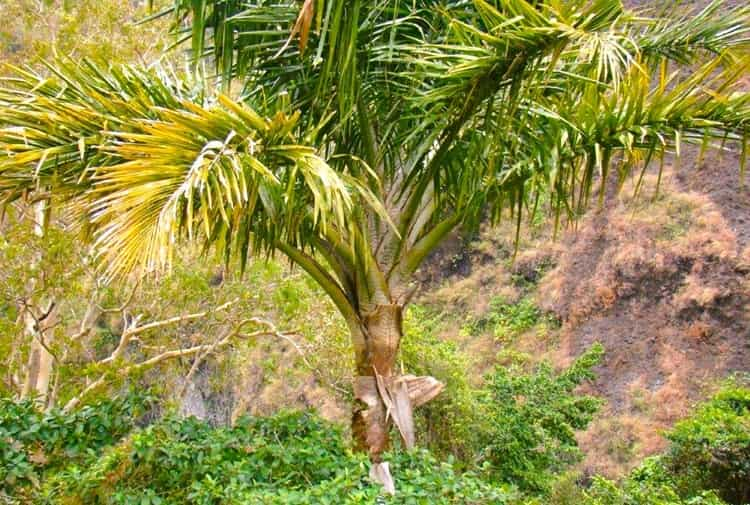 This Young Monocarpic, Solitary Metroxylon sagu Can Live A Long Life
This Young Monocarpic, Solitary Metroxylon sagu Can Live A Long LifeThen Flowers & Fruits & Dies. Photo: Widana53 - CC BY-SA 4.0
Also the thing to note is inflorescence length, a big help. Are they hidden by fronds, or do they extend out past the crown? Plus observe how they branch (many or few) & if any bracts are noted.
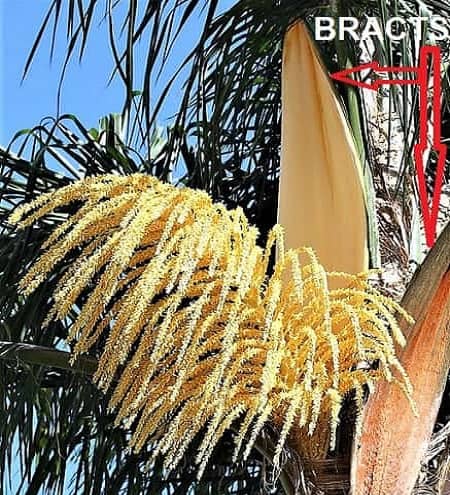
Takeaways for How to Identify Palm Trees
Getting to know their varied growth formats helps you to learn how to identify palm trees. Their unique styling, their beauty & so much more. Good to know for telling which of the many species of palms you're seeing.
With so many, many species, it's an exciting road to travel! Virtually & literally. Don't you think?
